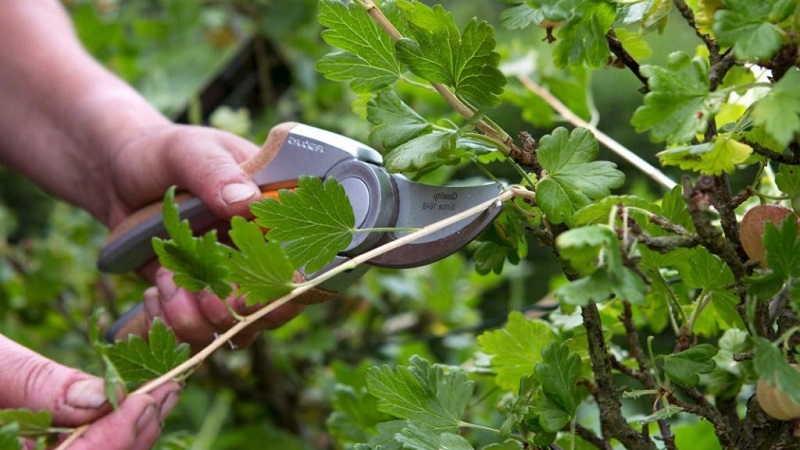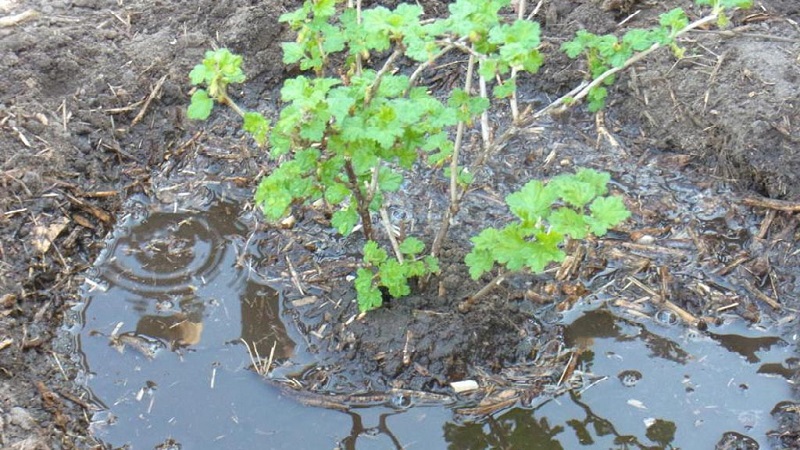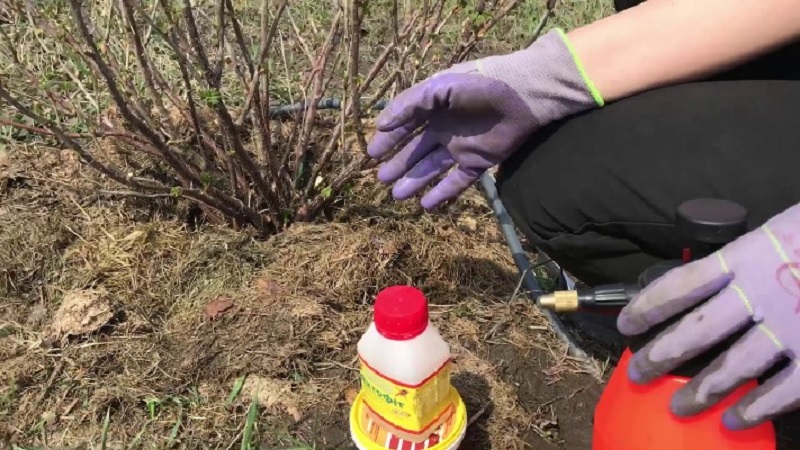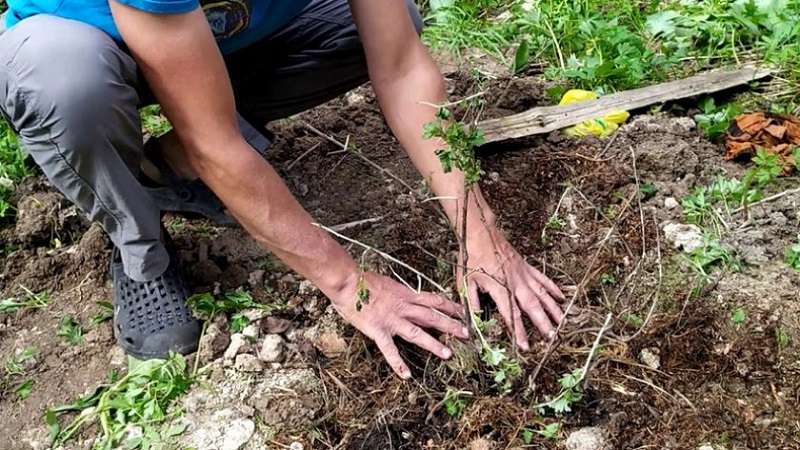Step-by-step instructions for caring for gooseberries in autumn and preparing for winter
Novice gardeners often ignore the recommendations for caring for gooseberries during the cold season. But timely pruning, treatment from pests and soil preparation will strengthen the plants against cold weather, protect against diseases and improve the quality of berries. Taking proper care of your gooseberries in the fall and preparing them for winter will ensure a stable summer harvest.
The content of the article
How to care for gooseberries in the fall
A well-developed, well-tended shrub will give the gardener more than 10 kg of tasty and large berries... With improper agricultural technology, the culture grows rapidly, which reduces fruiting.

What is being done in the fall:
- remove weeds and debris from the root zone;
- digging up the soil under the bushes;
- water the soil abundantly;
- feed the plants;
- cut bushes and thin out old branches;
- protect the culture from freezing in winter.
Autumn care for gooseberries
Activities for the care of shrubs in the fall are performed in a specific order. Let's start with trimming.
Pruning
In the middle of autumn, pruning shears sick, old and dry branches, broken, already bent to the ground and those that grow inward, thickening the bush.

Branches inclined to the ground are removed due to decay of berries near the soil... Shoots growing in the center of the bush prevent the plant from being blown by the wind, which increases the risk of fungal diseases. The quality and quantity of the crop depends on the correct and careful pruning of plants.
A garden saw removes shoots that are more than 5 years old, all sections are smeared with special paint or varnish.
In the first year of a shrub's life, its stems are shortened by only a third... The next year, 1-2 strong stems are left, cutting off their tops. All remaining shoots are cut so that there are no stumps left, which serve as a refuge for pests.
Important! In gooseberries at the age of 6 and 7 years, when pruning, no more than 6 strong and well-developed lateral shoots are left. It is they who will give a qualitative increase and a full harvest next year.
Positive sides of cropping:
- increasing the light regime;
- low risk of developing fungal diseases (for example, powdery mildew);
- increasing the quality and quantity of berries;
- the formation of the correct shape of the bush, which in the future will facilitate harvesting.
Interesting on the site:
Top dressing
To enrich the composition of berries, the culture is fed... In the fall, potassium and phosphorus are introduced (20 g and 30 g per 1 bush, respectively). The best months for fertilization are September and October.

For greater efficiency, add under the plants a layer of compost mixed with wood ash (no more than 10 cm in thickness):
- Compost - This is an organic mass that decomposes under the influence of microorganisms. It enriches the soil with nutrients. Fertilizer is made from tops, weeds and residues of garden plants, which are left to decompose. If the compost has a loose, uniform texture and a forest smell, then it is ready to use. For 1 gooseberry bush, add 3-5 kg of the finished mass.
- Ash - a natural product obtained by burning wood. It is poured over the soil around the plant in a ratio of 100 g per 1 m². Ash enriches the soil with potassium and phosphorus, prevents the development of diseases and the reproduction of pests.
Gooseberry fed with a mixture of mineral fertilizers (e.g. superphosphate and potassium salt).
Attention! Nitrogen is not brought in in the fall, since it activates the growth processes. As a result, the buds swell and the plants die in winter.
Watering
In the fall, the gooseberry continues to grow and strengthen the roots, forming buds for the future harvest, therefore watering is an integral part of preparing a crop for wintering... Shoots on which fruits are formed suffer from a lack of moisture. If the plants leave for the winter with a dry root system, the branches will dry out in the frost.

Water consumption: 30 liters per 1 bush... Planting is irrigated until mid-October. Hollows are dug around the bushes, water is poured under the root or along the grooves to avoid the occurrence of diseases. After all the moisture is gone, the grooves are buried.
Treatment
Small debris, weeds and rotten berries are removed under the roots of the gooseberry... Large plants are dug up with a shovel, since when pulled out, the roots often remain in the soil. Fallen leaves are collected with a rake so that pests and pathogens do not remain in it for the winter.
Important! Weeds at the roots of the gooseberry are removed in a timely manner - they contribute to an increase in humidity, which is why diseases develop.
Protection against diseases and pests
To prevent the occurrence of diseases and pest attacks in the fall, gooseberries are treated special preparations (Bordeaux mixture, copper sulfate and various insecticides).
This is done in late October - early November.
Basic insecticides:
- "Lepidocide": diluted in 10 liters of water, used within a week;
- "Bitoxibacillin": dilute 100 g in 10 liters of water;
- "Actellik": dilute 15 ml in 10 liters of water.

Complex fungicides are used to protect bushes.which protect plants from powdery mildew, leaf rust and anthracnose. Spraying is carried out after harvest and before flowering.
Fungicides:
- "Topaz" - prevention and treatment of fungal diseases (powdery mildew, rust, septoria). The active ingredient is penconazole. Application: 1 ampoule of the substance is dissolved in 10 liters of water and sprayed on the bushes.
- "Fundazol" is used to combat late blight, anthracnose, yellow rust. The active ingredient is benomyl. The product penetrates deep into the roots, spreading throughout the plant, without touching the fruit. Application: 1 g per 1 liter of water. Bushes are sprayed for prevention, watered for treatment.
Preventive treatment of gooseberries promotes better fruiting... It is important to observe the indicated proportions and to choose the right preparations.
Read also:
A guide to properly preparing grapes for winter
Guide to pruning sea buckthorn in the fall
How and what to fertilize currants in the fall for a good harvest
How to prepare for winter: shelter and insulation
After cleaning the gooseberries, saturating the soil and protecting against pests, the stage of preparing shelters and insulation begins.
Gooseberries growing in mild climates will not need shelter. In harsh regions at -40 ° C, the plant freezes out, so it is insulated:
- The branches are pulled into a bundle and tied with twine, tilting closer to the ground.
- The bush is covered with sawdust or dry leaves.
- Burlap or agromaterial is placed on top, fixing the edges with bricks and boards.
In some cases, the shelter is built without tying the gooseberries.... It is enough to put 2 criss-cross arcs over the bush, pulling several layers of agrotechnical on them. Staples are inserted into the ground from below and reinforced with bricks.
A simple way to insulate gooseberries is to cover them with a 10 cm layer of snow. The soil is additionally mulched in various ways:
- Manure or peat. Apply a layer more than 10 cm in height. Suitable not only for insulation, but also for feeding.
- Mulch bags. The material is poured into paper or polyethylene bags and holes are cut into them. Most of the substance will spill to the ground through the holes.
- Insulation materials, for example, with agrospan, cover all the bushes. Sometimes it is replaced with polyethylene, but it is not very convenient.

Care depending on the age of the plants, the growing region and the variety
Unlike bushes 6-7 years old, when pruning young seedlings, 3-4 healthy branches are left... On average, 4-5 kidneys remain on them. The same number of buds are left on a newly planted gooseberry. Shoots that grow from the ground are shortened by 1/4. In mature plants, all old branches are removed.
Preparing gooseberries for winter in all regions consists of the same stages, they differ only timing of events:
- In Siberia preparation begins in early autumn. Due to the harsh winters, the bushes are insulated every year. Great attention is paid to feeding, as high-quality fertilizers increase the winter hardiness of plants.
- In the Urals gooseberries are watered in early autumn, and insulated in winter, sprinkled with snow or other material.
- In the middle lane Russian culture is insulated annually.
- In North-west - upon reaching -30 ... -35 ° C.
- In the southern regions pay attention to abundant watering.
Gooseberry is an unpretentious and strong plant that can withstand strong wind and cold... Therefore, there are no special characteristics for caring for different varieties.
Important! The exception is southern non-zoned and young plants, which are advised to be insulated with peat. The most important thing is to observe prevention, fertilize and cut gooseberries in time.
Experienced gardening tips
Experienced farmers know how to help plants during the cold season:
- don't prune gooseberries too early;
- remove large branches with a long-handled lopper;
- trim and studless varieties.
It is not advised to grow bushes in one place for more than 8-10 years - their berries begin to shrink.
Conclusion
In order to competently prepare the gooseberry for winter, a number of procedures are performed in the fall. Pruning the bushes will provide a full-fledged crop in summer, feeding will fill the culture with nutrients, and processing with special means will reduce the risk of developing diseases and pests. To save plants from freezing, they are insulated with mulch, snow or agromaterial.